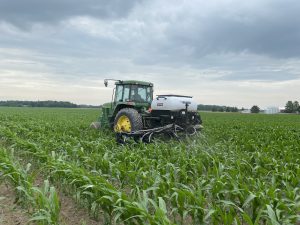Research being done at the Blanchard River Demonstration Farms and other related sites around the state is helping researchers determine what practices work best for reducing nutrient and sediment loss. Over the last five years, on-farm research has shown that three practices in particular help reduce nutrient and sediment loss:
- Following the 4R approach
- Reducing soil erosion
- Developing a water management plan
Keeping valuable topsoil on the farm is critical to sustainable agriculture, and reducing soil loss can play an important role in water quality concerns downstream.
Soil erosion is the gradual process of deteriorating or wearing away a field’s topsoil by water, wind or mismanaged human activities.
Improved soil health and the use of cover crops can reduce soil erosion.
Soil Health
Soil health is a condition of the soil and its potential to sustain function within its natural or managed ecosystems. Soil health can be evaluated by several indicators, including pH, aggregate stability, available water capacity, active carbon and organic matter.
How it helps: A healthy soil performs many vital tasks, including regulating water and filtering nutrients. By improving soil structure, water can better infiltrate the soil profile and be absorbed.
“If you’re going to choose a practice as a fix (for a problem), it better be right. That’s why I think this testing is so important.” – Chris Kurt

Cover Crops
Cover Crops such as cereal rye, oats and winter wheat are planted to temporarily protect the ground from wind and water erosion and supply living roots to the soil during times when cropland is often not adequately protected.
How it helps: Keeping living roots in the soil as much as possible help improve soil health by adding organic matter and biological activity. The root structure of the cover crops also helps hold the soil in place during a season when the ground would otherwise be bare.
Preliminary research from edge-of-field studies shows cover crops can be excellent scavengers of nitrogen and help reduce the amount of what that leaves the field. Additional longer-term research is needed to develop conclusions about dissolved reactive phosphorus.
This article was featured in the July/August 2021 edition of Our Ohio Magazine.


